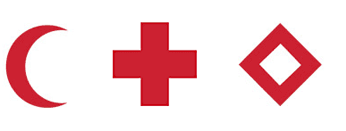The Red Crystal

For some companies, brand recognition is a matter of profit and loss. But for the International Committee of the Red Cross (ICRC or Red Cross for short), brand recognition is a matter of life and death. In order to serve its mission of protecting humanitarian and medical personnel on battlefields around the world, the Red Cross’s symbols must be absolutely recognizable and their meanings must be absolutely clear. Two of these symbols are well known: the Red Cross and the Red Crescent. And, as of 8 December 2005, the organization has elected a third: the Red Crystal.
The adoption of this “third Protocol emblem” (as it is officially known) is the first new symbol recognized by the Red Cross since the adoption of the Red Lion and Sun in 1923, a special symbol for Iran that, while still recognized, has not been used since 1980. In 1957, Sri Lanka tried to establish the Red Swastika, which is a Hindi symbol of good luck, but was rejected. India tried again in 1977 and was also rejected. And, for the last 50 years, Israel has requested the addition of a Red Star of David, known to Israelis as Magen David Adom, but that request has also been rejected.
The reason for these rejections is simple. The Red Cross fears that if emblems become more specific and more numerous, these same emblems will compromise the safety of those the Red Cross has sworn to protect. While we can rely on soldiers in the heat of battle to recognize perhaps two or three symbols of protection, we cannot rely on them to recognize two or three hundred. Moreover, the limited number of marks has a unifying purpose, aligning individuals from different countries under a common goal. To allow symbols for the Red Cross to become veiled symbols for their host countries would be to risk rendering those symbols useless. Rather than conveying neutrality, it’s possible they could invite hostility.
Unlike the cross, crescent, or six-pointed star, which are commonly seen in religious institutions, the place we’re most accustomed to seeing shapes like that of the Red Crystal is on roads and highways, where it is the shape of many of the signs themselves. The symbol’s design, with an empty center, emphasizes its connection to a frame. The symbol is an empty vessel, a neutral shape, a sign of sign-ness. As such, it is hard-wired in our brains as something that means, simply, “take notice,” and that reaction is precisely what the Red Cross wants. As shown on their website, the Red Crystal’s frame can remain empty, as it will for Israel, or it may carry the mark of the Red Cross, Red Crescent, or – in the case of Eritrea – both.
The Red Cross’s name is itself a description of its visual mark, like Target and Apple. The symbol showing a red cross on a white ground (an inversion of the Swiss flag), was devised at the inception of the Red Cross movement by its founder, Henri Dunant, in 1863. White flags were typically used in battle to communicate surrender, so Dunant thought a largely white flag would make troops more respectful of the new, peaceful organization. Once an affluent businessman with interests in North Africa, Dunant’s passion for launching the Red Cross left him broke and homeless on the streets of Geneva. After withdrawing to the secluded Swiss countryside for most of his life, Dunant finally went on to win the first Nobel Peace Prize in 1901.
The Red Crescent was introduced in 1876 during an armed conflict between Russia and Turkey after many Muslim nations refused to recognize it. For decades, Israel had been seeking similar consideration from the ICRC, but it was not until the American Red Cross, lobbying on behalf of Israel, withheld almost $35 million in its subscription fees to the ICRC that the organization began serious talks about the creation of a neutral symbol. While no country or national society will be required to change their emblems, none will be required to use the Red Crystal either, but all nations will be required to respect it. While the resolution to adopt the Red Crystal did not pass unanimously, only Syria was vocal in opposition to it.
In every piece of communication, visual or verbal, there is a sender and a receiver. The degree to which the communication remains intact and intentional from one to the next relies on an absence of “noise,” or interference. In the case of the Red Cross, noise might come from a lack of visibility (the symbol cannot be made out on the door of a muddy jeep), or it might come from a bias inherent to the sender or receiver (the symbol is not recognized because it is also a symbol from a warring religious group).
While it has done literally everything in its power to minimize noise in the first case with a clear and readable logo, the Red Cross has done little over its history to minimize noise in the second case, leaving both of its major symbols vulnerable to cultural bias. The Red Crystal, then, is a major step in the right direction for this groundbreaking organization. Like all doctors, the Logo Doctors are fans of the Red Cross. Now we have one more reason to celebrate. If one type of successful mark must make a call to action, there is no greater call than, to borrow from the words of Hippocrates, “First, do no harm.”